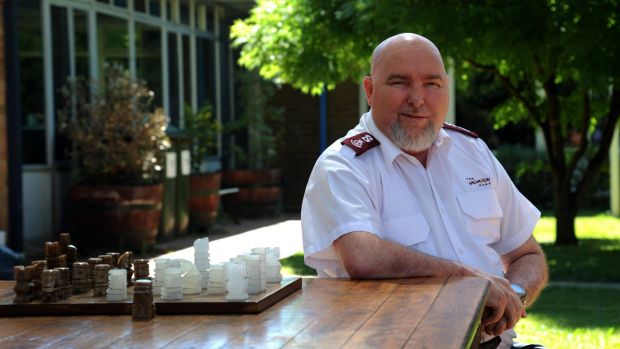
Major Scott Warrington, from the Salvation Army, said waiting times for his rehabilitation centre in Fyshwick were now about around six weeks. Photo: Elesa Lee
Canberra’s drug treatment services are calling for additional funding and support, with waiting times climbing to many months and staff struggling to deal with dangerous work environments and mental health challenges.
According to a Productivity Commission report released this week, the ACT has the lowest number of rehabilitation providers in Australia despite treating double the number of patients as Tasmania and 20 per cent more than the Northern Territory.
Major Scott Warrington, of the Salvation Army, said waiting times for his rehabilitation centre in Fyshwick were now about six weeks, which was causing additional problems for those seeking treatment.
“By the time most people ring us they are already at the point where they feel like they are going to die at any minute or do something crazy and hurt themselves,” he said.
“I had one guy come off the street the other day who was basically homeless, with a drug addiction and starving to death.
Directions chief executive Fiona Trevelyan said positions for men at the agency’s 10-bed residential facility in Bruce had been closed temporarily, with waiting times of more than two months.
“The number of people who contacted Directions for treatment in January was double what was recorded a year earlier,” she said.
Ms Trevelyan said the waiting lists were the result of “significant underfunding” rather than a lack of providers, as the providers worked well together.
Mr Warrington said his staff did their best to assist people while they wait for treatment but there was only a limited amount they could do with current capabilities.
“If I fill up all my beds then I’ve got to wait for someone to leave before I can let people in and at the moment no one is banging down the door to leave,” he said.
“We do our best to refer them [clients] to people who might be able to support them during the transition and there a few services in the ACT that can help with that, and we encourage them undertake meetings in the community.”
In January, Directions chief executive Fiona Trevelyan said the waiting list for the 10-bed residential facility in Bruce was about eight weeks.
According to the latest productivity commission, there were 10 treatment services in the ACT during 2013, completing more than 4400 treatment episodes, compared to 2338 episodes in Tasmania with 17 treatment centres.
Mr Warrington said his centre was running at double the capacity it was in 2009 and additional funding would allow it to reduce waiting times.
“When I first came to the ACT about five years ago we were averaging about 16 to 20 beds and now we’re running close to 40 beds being filled on a consistent basis,” he said.
“Now you could have a list of about 20 phone calls over about two to three days from people desperate for a bed”
“We need better funding so that we can hire the appropriate staff for the mental health requirements. We would be blessed to have psychologists or psychiatrists who could work throughout our services.”
“We also need to have better security for clients out of hours and to have two people on [duty] rather than just one –that would ease the stress on our services.”
Ms Trevelyan said there had been no significant increase in funding for the ACT drug and alcohol sector during the past 10 years, despite the increasing demand.
“If we were able to employ more staff we could be more responsive to community needs,” she said.
